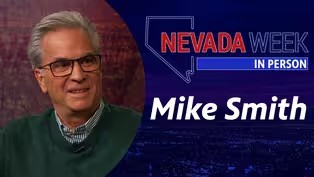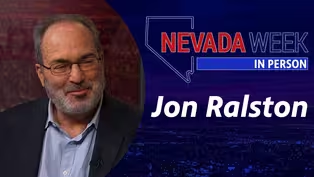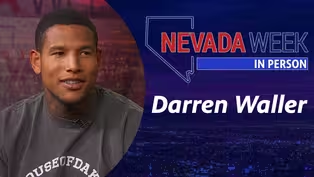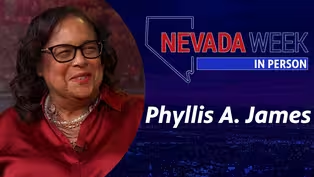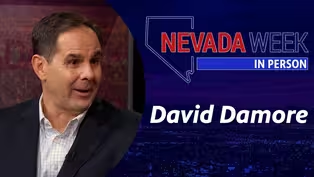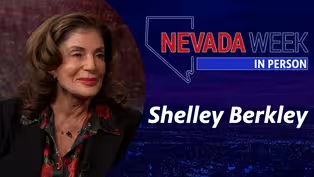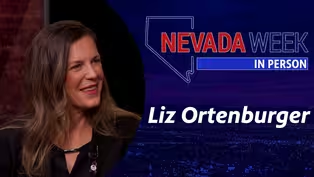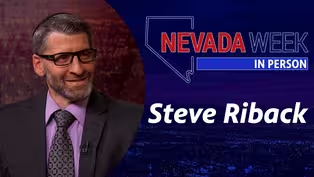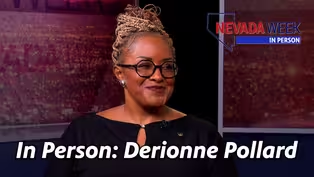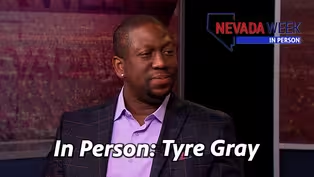
Nevada Week In Person | Sarah O’Connell
Season 1 Episode 43 | 14mVideo has Closed Captions
One-on-one interview with Director of Eat More Art LLC Sarah O’Connell.
One-on-one interview with Director of Eat More Art LLC Sarah O’Connell.
Problems playing video? | Closed Captioning Feedback
Problems playing video? | Closed Captioning Feedback
Nevada Week In Person is a local public television program presented by Vegas PBS

Nevada Week In Person | Sarah O’Connell
Season 1 Episode 43 | 14mVideo has Closed Captions
One-on-one interview with Director of Eat More Art LLC Sarah O’Connell.
Problems playing video? | Closed Captioning Feedback
How to Watch Nevada Week In Person
Nevada Week In Person is available to stream on pbs.org and the free PBS App, available on iPhone, Apple TV, Android TV, Android smartphones, Amazon Fire TV, Amazon Fire Tablet, Roku, Samsung Smart TV, and Vizio.
Providing Support for PBS.org
Learn Moreabout PBS online sponsorshipMore from This Collection
Nevada Week In Person | Beverly Rogers
Video has Closed Captions
One-on-one interview with Rogers Foundation chair Beverly Rogers. (14m)
Nevada Week In Person | Mike Smith
Video has Closed Captions
One-on-one interview with Las Vegas Sun political cartoonist Mike Smith. (14m)
Nevada Week In Person | Jon Ralston
Video has Closed Captions
One-on-one interview with The Nevada Independent CEO Jon Ralston. (14m)
Nevada Week In Person | Darren Waller
Video has Closed Captions
One-on-one interview with Las Vegas Raider tight end Darren Waller. (14m)
Nevada Week In Person | Phyllis A. James
Video has Closed Captions
One-on-one interview Phyllis A. James. (14m)
Nevada Week In Person | David Damore
Video has Closed Captions
One-on-one interview with Chair of the Department of Political Science at UNLV David Damor (14m)
Nevada Week In Person | Shelley Berkley
Video has Closed Captions
One-on-one interview Senior Vice President for Touro University Shelley Berkley. (14m)
Nevada Week In Person | Liz Ortenburger
Video has Closed Captions
One-on-one interview with SafeNest CEO Liz Ortenburger. (14m)
Nevada Week In Person | Steve Riback
Video has Closed Captions
One-on-one interview with Las Vegas Metro Police Lieutenant Steve Riback. (14m)
Nevada Week In Person | DeRionne Pollard
Video has Closed Captions
One-on-one interview Nevada State College President DeRionne Pollard. (14m)
Nevada Week In Person | Kelly Maxwell
Video has Closed Captions
One-on-one interview with Baby’s Bounty Executive Director Kelly Maxwell. (14m)
Nevada Week In Person | Tyre Gray
Video has Closed Captions
One-on-one interview with Nevada Mining Association President Tyre Gray. (14m 1s)
Providing Support for PBS.org
Learn Moreabout PBS online sponsorshipAn internationally trained theatre director and producer committed to amplifying the role of art in Southern Nevada, Sarah O'Connell of Eat More Art Vegas joins us this week for Nevada Week In Person.
♪♪♪ Support for Nevada Week In Person is provided by Senator William H. Hernstadt.
-Welcome to Nevada Week In Person.
I'm Amber Renee Dixon.
Sarah O'Connell has served as artistic director at The Asylum Theatre in Las Vegas since 2003.
An adjunct professor at UNLV and CSN, she helps keep Southern Nevadans informed about the local performing arts available for their consumption through her website, eatmoreartvegas.com.
Sarah O'Connell, thank you for joining us.
-Thank you.
It's great to be here.
-So Eat More Art Vegas, it's a company and a website.
Where did you come up with that name?
-Well, you are what you eat, so you should eat more art.
It's that simple.
-I like it.
And the website, how does it work?
What does it do?
-Well, I started it several years ago to help promote the local independent arts and culture community because there was a lack of coverage in local media, and arts is all local.
So we created our own way to promote local arts.
And over the years, it's grown into a monthly community meeting and other advocacy as well.
-So remind me again, the need for it was?
-There was not a enough coverage of all the work that goes on.
We've long been accused of being a place lacking culture.
And the reality is that people just are forgetting to look in places off the Strip to find it.
-How much is available off the Strip that people don't know about?
-Well, it's actually hard to quantify, because you're talking everything from some kind of programs you might have in schools, to community centers, to independent companies like my own, The Asylum Theater.
You're also talking about programs in Parks and Rec and other kinds of commercial work.
Basically, I tell people that the arts are the water we swim in; but like fish, we don't know that there's water out there.
-Okay.
So people, it is available out there, but you have to, you know, perhaps visit a website to figure out what's going on.
-Yes.
You know, Vegas is a media capital, but there's a lot of competition, even for the people like the MGM.
So if you're a small company, you need all the help you can get.
So we work together.
-What would your argument be to people as to why they should consume more art?
-Well, when you think about what art is, it's an expression of our humanity.
Our arts and our creativity is how we human.
It's the one thing we bring to the universe that all other objects in nature don't, which is our imagination and our ability to change things.
So we don't just have to go with the course of nature, we can create something new.
And so every time you experience something creative in your life, it opens up your own creative abilities.
-That's exciting.
For people who may not be creative, is that also a possibility?
-Well, the idea of art is that there's someone who might make something to express something, but there's the audience that has to receive the message and give feedback.
So the reality is that, particularly in something like performing arts, it's not theater without an audience.
And so really, you don't have to be the maker to be part of the artistic creative world.
-Your passion for the performing arts, how did that develop?
-Well, I think part of it is I have a sort of passion for empowerment, and I sort of also enjoy working together with people.
I like building community and finding ways to invent, rather than destroy.
And so that's why I like art, and that's why I love theater, because theater is something that can only happen between people, and they have to work together on it.
The other thing I love about the theater is that it's a chance to travel places you've never been before without leaving your neighborhood.
-Why do you bring up that aspect about destroying instead of-- well, creating versus destroying?
-Well, when you think about the energy you have in life and you only have one life to live and you see a problem, we can curse the problem or we can invent a solution.
And so I just find that I feel more fulfilled in life when I'm making life better instead of just wishing it was different.
-I see.
I see what you mean.
Originally from the Bay Area, you got your Masters of Drama in Directing from the Royal Conservatoire of Scotland.
-Yes.
-What kind of impact did that have on you?
-Oh, it was a life changing experience, as I'd hoped it would be.
I knew that America is a big country but that art is a global thing, and you have to travel far to get a sense of other kinds of art.
So I wanted to study abroad.
And over there, I learned about how art works in other places as a tool and not just an entertainment.
And I took that back, and that's what I've tried to do here in Southern Nevada is take that lesson to the people here.
-Could you give me an example of that, of art as a tool?
-Well, my own company, The Asylum, has several great examples.
During the pandemic, when everything was closed and all of our artists were out of work, we helped lead a community project to get grants to pay musicians to perform in vaccine clinics so that when people were at the convention centers, they could hear classical music if they were nervous about getting shots.
We had Broadway performers who are living in town come perform, and that was just during closure.
Then we did in June-- The war broke out in Ukraine, and we connected with our partners in Kyiv.
And we simulcast a live performance from a theater turned into a bomb shelter onto the Winchester center stage, along with live performances by local immigrant performers.
And then we just closed a production that was a new translation by a local playwright of a famous Colombian playwright from years ago.
That was just last weekend.
And we build bridges that way, and we find ways to give diverse voices the stage to connect the world and to show people that we are not as different as we might think.
-So Scotland, as I mentioned.
You also worked in Central Italy.
You've been all over the world, which I think speaks well for you choosing Las Vegas to establish roots in.
What was it about Las Vegas?
What brought you here, and what do you love so much about it?
-Well, I'm part of an arts family.
My husband is a lighting designer and director.
And he came here-- We kind of came here in that sort of post dot-com bomb era, after 9/11.
Because in the trade show and entertainment and rock and roll industry, a lot of people came to Vegas first rather than travel elsewhere.
So the work was here for him.
So he followed the lighting industry, and I followed my lighting company and my husband.
-Okay.
And that brought you here.
-Yes.
-And then you did decide to establish roots here.
-Right.
-What is the arts and culture scene like here, from your perspective, and the theatre scene?
-It's very exciting always, because the the kind of diversity of the people who come together to create art is like no other place I've ever traveled.
There's people from all over the world here.
So you have international artists mixing with people from high school, all working on the same quality experience for the public.
And that's the kind of training that you can't create in a laboratory; you just have to be out in the world doing it.
So it's a good place to prove yourself, like in the mean streets, as opposed to at a fancy institution.
But at the same time, it's a developing community.
It's still pioneering here.
And if you're a creative person, you want to build something new.
And so that Vegas vibe is the right energy for an artist here.
-Let's talk about currently how arts and culture is doing in Las Vegas a little bit more than two years after the pandemic.
-You know, it's tough to say in some respects.
On one hand, everyone was so glad to have the opportunity to get out and about back.
We relied on it to survive--all the closures, all of the performances, and things like that.
Even-- I was working as executive director of the Henderson Symphony during the pandemic, and we provided concerts that were live streamed from City Hall at the holidays.
We were there to try to bring our community some comfort.
And so that was really great.
But then the pandemic kind of was way down, everything opened.
And people started to fall into some old grooves where they got back caught into the stuff that's on maybe on the Strip or a lot of the sporting events.
They might have forgotten about those companies, and so there's a bit of an effort right now to remind people to keep with the local arts community, even though there's other things to do too.
-And you are helping to remind people of that, in part, with an economic study that you have been contracted by the City of Las Vegas to take part in.
First time that the City is taking part in this national study.
What does it do, and why is it important?
-Yes.
We call it the AEP6, Arts & Economic Prosperity.
And it's the sixth because it's the sixth time the country has done it, but it's the first time that Las Vegas and Clark County have signed on as partners.
And that means for the first time ever, we're going to be able to count how much money our local nonprofit arts community makes for Southern Nevada and the country as a whole.
So we're going to survey all the audiences, and then we take that number and we send it to the National Americans for the Arts office.
And they're going to tell us exactly how much money we get for every dollar donated to the arts.
-How well understood is it how economically impactful the arts is here in Las Vegas?
-Well, the pandemic was an eye-opener because people realized, as I like to point out, that we don't necessarily ride on gaming, we ride on gathering.
When people couldn't come to concerts, trade shows, all of those kinds of events, that's when the hotels had no one to book.
And so I think that one of the things we want to do in diversifying our economy is truly understand what makes us prosperous, and it's actually that water we swim in.
So when we didn't have it, we felt it.
We missed it.
And now it's about realizing, Oh, what was I missing all along, and can we leverage that to an exponential benefit for everyone?
So counting how much money we make for the general population by doing arts and cultural events, whether they're big or small, is a way for us to show, these are places you could be leveraging.
These are creative workers you could be developing.
This is a place that Nevada can be leading if you identified it.
-In an opinion piece for the Nevada Independent in March 2021, you said, quote, Local cultural strategists are not regularly included in stakeholder conversations about economic development at the state level, and so decision makers don't know what they do not know, end quote.
-Yes.
-What would you be telling those stakeholders about art?
-That you make more out of it when you leverage things, and what they tend to do is dissect them and separate them.
And where we see that most painfully hitting us in our economy is by separating the nonprofit arts from our understanding of the commercial creative sector.
So people will often compare Cirque on the Strip versus a theatre company like mine, The Asylum, not realizing I hire the same actors.
We're the same lighting designers.
The creative workforce sits at the intersection where all roads of industry meet, and we're the only ones who see everyone.
And if people understood that we're catalysts for innovation and change, they would realize that we shouldn't be passed through.
We should be consulted, because often people will make a lot of investment in, say, a facility, but not ask the creative community, Hey, could you really make the most of it if it was designed this way?
And we say, Well, if you just made this little adjustment, we could use it a lot; otherwise, it's dormant.
So a lot of things get invested in for like building new venues.
Or they might make some kind of policy about transportation, not realizing they're cutting off the creative economy at the knees.
So if they had us on the same team that they have all the other consultants when they're first talking, they might avoid a lot of roadblocks.
-Could you give me another example of how the creative industry could help in policy?
What kind of policy might you come up with?
-Well, I think small business development is the first most useful target, because you have in this area, a lot of freelancers.
And we started to realize when you talked about people who were non-payrolled employees not getting unemployment during the pandemic, what you're really seeing are all the people who've been working the gig economy here all along.
And I don't think that we realize how much we rely on that workforce, because they're invisible to us.
Because they aren't counted, like, in regular payroll reports, they're a 1099 employee.
But we have to understand the entire production industry, the nonprofit industry, the tradeshow industry, those all run on stage hands.
Those stage hands are freelancers, and if you're not counting them, they're invisible to you.
You're not realizing, Oh, if I want to keep that person with that skill here, I need to make sure they can work in the nonprofit sector and the commercial sector so they can have a whole career.
And so we're trying to show that the small business development is a place where if you put nonprofits next to entrepreneurs, they can start to build a stronger foundation to create a workforce to thrive.
-And nonprofit and profit arts, they do intertwine?
-A hundred percent because, first of all, you have things where one group might contract another to work for them.
I run a nonprofit theater, but I'm still going to hire a design house to build my set.
I'm going to pay a professional performer to give a performance.
So I'm bringing in commercial workers to achieve my nonprofit mission, and that works the other way around.
You would not have commercial workers if you didn't have nonprofits trading them.
-Sarah O'Connell, Eat More Art Vegas, thank you for joining us for Nevada Week In Person.
To see more of Nevada Week In Person and this week's edition of Nevada Week, go to vegaspbs.org/nevadaweek.

- News and Public Affairs

Top journalists deliver compelling original analysis of the hour's headlines.

- News and Public Affairs

FRONTLINE is investigative journalism that questions, explains and changes our world.


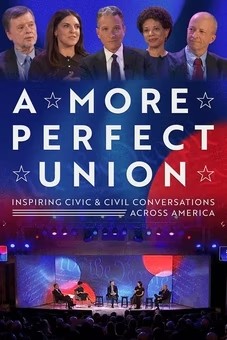

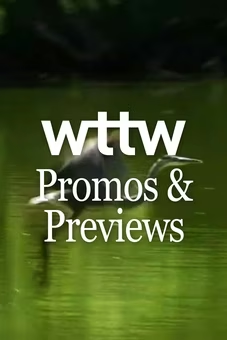







Support for PBS provided by:
Nevada Week In Person is a local public television program presented by Vegas PBS

